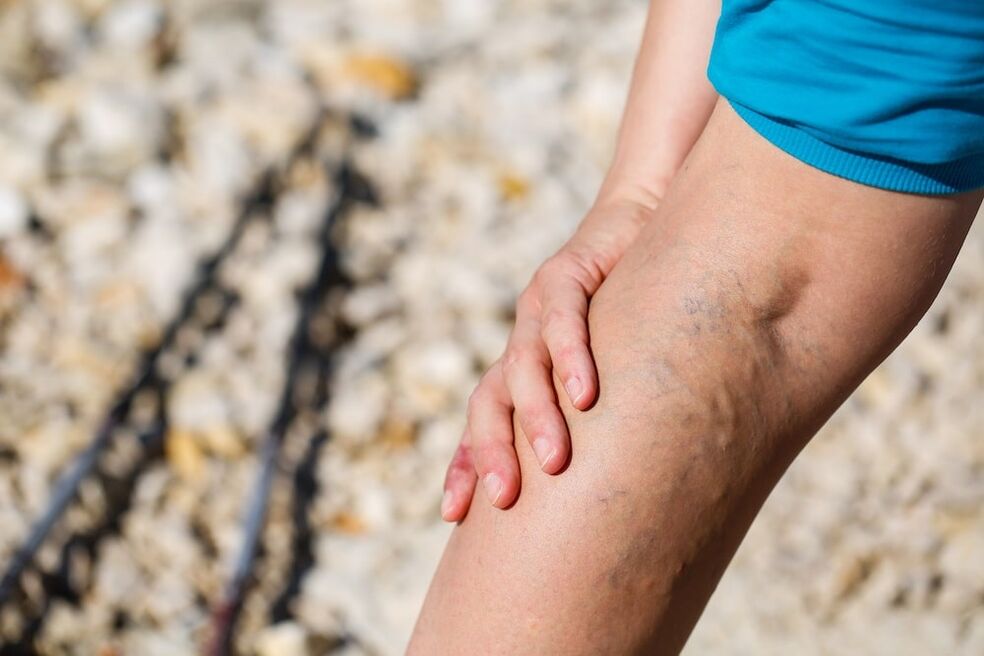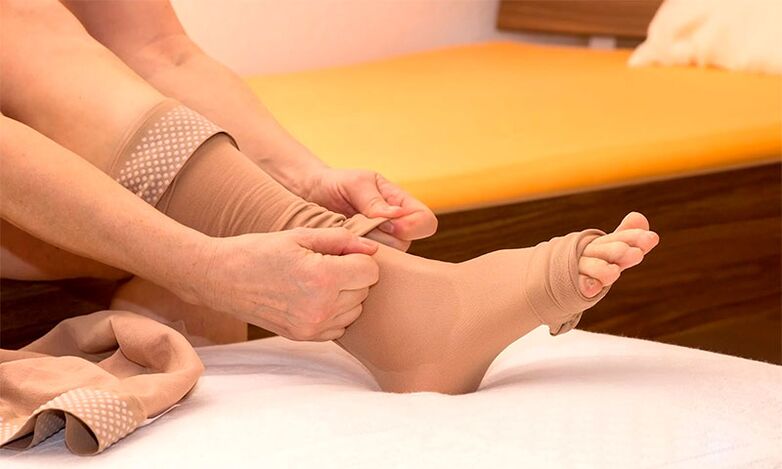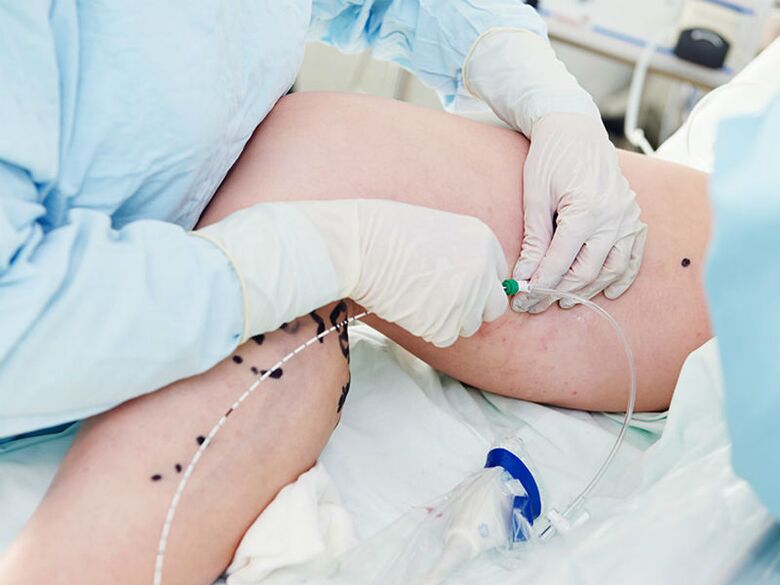The varicose veins (varicose veins): a condition in which the veins increase in the diameter, become winding. Most of the time this is due to the deteriorated work of venous valves.

Venous systemCharacteristics of the structure of the veins.
Venous vessels are part of the cardiovascular system, they carry blood from peripheral tissues to the heart. The opinion that venous blood always flows through the veins, and the arterials always flow in their veins. In fact, this is not always the case. For example, pulmonary arteries carry venous blood from the heart to the lungs, and pulmonary veins are returned from the lungs to the heart of the artery.
In many arteries, blood flows under high pressure, so they have a dense thick wall. On the contrary, in the veins the blood pressure is quite low, so its wall is thinner and less dense. In the light of many veins there are valves, blood passes in one direction, thus contributing to its progress to the heart. The valves are absent only in the veins of the head and neck, since they are above the heart, the blood flows freely.
What happens in the veins? The essence of varicose veins.
The walls of the veins of the lower extremities are forced to constantly experience greater loads, since the exit of blood through these vessels occurs against gravity. The main mechanisms that lead to varicose veins:
- excessive venous wall stretching;
- Interruption of venous valves.
It is far from being possible to say exactly why these pathological changes occur in the veins. There are factors that increase the risk of varicose veins.
The causes of varicose veins
Factors that increase the risk of the disease:
- Leader. This factor is present in all people. The legs are the farthest from the heart of the body, which is under the rest during the position and the walk. Venous blood is more difficult to return to the heart of the feet.
- Age. As the risk of varicose veins increases, as venous valves wear. They stop closing completely, so that a small amount of blood can flow in the opposite direction. She stagnates in the veins of her legs, instead of returning to heart.
- Floor. Women suffer from varicose veins more frequently than men. This is facilitated by hormonal changes in the female body during pregnancy, in postmenopause, before menstruation. Female sex hormones contribute to the relaxation of the walls of the veins.
- Hormonal replacement therapy and taking oral contraceptives.
- Inheritance. The more family members suffer from varicose veins of the lower extremities, the greater its risks.
- Obesity. Extra Pounds contribute to increasing load in the cardiovascular system. The pressure in the veins increases.
- Standing or sitting for a long time. This leads to the stagnation of the blood in the veins at the bottom of the body. For example, office workers, surgeons and other people who are "standing" and work "sitting" often suffer from varicose veins.
- Pregnancy. During pregnancy, women suffer from varicose veins much more frequently than in other periods of life. This is due to some physiological changes in the body of a pregnant woman.

Signs of varicose veins
- Notable expansion of subcutaneous veins. They increase, they become sinuous, well visible under the skin. The veins variceously dilated are often seen as cereals, the "worms" of blue or dark purple. Such image occurs only with varicose veins located under the skin. If the deepest venous ships in the fabrics are affected, it is impossible to notice this externally.
- Feeling of severity in the legs. In general, it occurs or intensifies after intense physical effort, at night and at night.
- Several unpleasant sensations. It can be an ardor feeling, a feeling of pulsation, tingling, numbness.
- Swelling on the legs. The stagnation of the blood in the varicose veins leads to the fact that the fluid begins to take and accumulate in the tissues. Edema occurs closer at night, as a rule, first only on the feet. As a rape of venous blood exit increases, swelling extends to the bottom of the legs, hips.
- Muscle cramps. They arise due to a violation of the blood supply to the tissues, when a person represents a lot of time.
- Leg pain. Not all patients are worried. Intensify with a prolonged position.
Complications of varicose veins
In most patients, varicose veins do not lead to complications. But the following states can occur:
- Bleeding. In case of skin damage in the area of varicose veins, bleeding occurs, which may not stop for a long time. In such cases, you must go to bed, lift your legs and press the bleeding area. If the blood continues, you should consult a doctor.
- Ulcers for varicose veins. Very painful, more often located on the ankle. Ulcers occur due to edema and blood supply altered to tissues in the area of varicose veins. Usually, an ulcer is preceded by a pale spot on the skin. If this complication arises, you should immediately consult a doctor.
- Thrombophlebitis for varicose veins. A condition in which blood clots grow in the venous wall and inflammation occurs. In the damage area, a sense of heat, redness, pain can occur. In general, with this complication, the doctor prescribes compression linen, analgesics.
- Chronic venous deficiency. A condition in which oxygen exchange, nutrients and waste products between skin and blood is altered, due to deteriorated blood supply. Chronic venous deficiency increases the risk of pathologies such as eczema, dense dense skin, trophic ulcers.
- Venous eczema (stagnant dermatitis). Skin lesion caused by stagnation of venous blood and edema formation. The main symptoms: red spots, peeled, itching in the field of varicose veins.
- Restless legs syndrome. It is characterized by unpleasant sensations in the legs that arise at rest. The patient must constantly make movements, so the dream often bothers.
Compression linen for varicose veins
Compression stockings and elastic bandages with varicose veins compress dilated veins, thus improving blood circulation. As a general rule, compression underwear wraps the legs around the ankles more strongly, and gradually becomes freer. It helps blood to move through the veins in the direction of the reverse force of gravity, to the heart.
Many patients point out that compression socks and elastic bandages help cope with discomfort, pain, edema.
Despite the fact that compression linen helps improve blood flow and cope with some symptoms, do not heal varicose veins. During the studies, ambiguous results were obtained, so scientists cannot say if compression means help eliminate or prevent varicose veins.

Compression linen varieties:
- Socks and stockings. The most common type of compression laundry. The stockings reach the hips, stockings, to the waist. Compression stockings are more convenient, since they are safely and do not slide.
- GolfsThey reach the knee. Often used by men. There are different models.
- Elastic bandagesThere are different lengths, they can only be destined to bandage the lower leg or leg and hips. This is the cheapest variety, but more uncomfortable with compression linen. The bandage must be applied longer than putting socks or half, it slides constantly. The degree of compression is manually controlled by regulating the resistance of the bandage, and is not always adequate.
Operations for varicose veins
With varicose veins pronounced on the legs, they turn to surgical treatment. In general, the operation is performed under general anesthesia. In most cases, the patient is discharged from the hospital on the day of surgical intervention. If the operation is carried out in two legs, then it may be necessary to spend a night in the hospital.
There are different types of surgical treatment of varicose veins.
Dress and eliminate an expanded vein
Two cuts are made: one in the groin, the other below, in the ankle, the knee or elsewhere. In the upper section, it is bandaged and crossed by a vein. Through it, a special thin cable is carried out to the lower section, after which it is thrown together with the next. Eliminating the superficial vein will not affect the supply of blood to the leg, since its functions will take deep veins.
Possible complications of dressing and elimination of the vein:
- the formation of large hemorrhages;
- bleeding;
- pain;
- A very rare complication is deep vein thrombosis.
The restoration of performance after this operation in most patients occurs within 1-3 weeks. All this time will have to use compression stockings. If there is venous insufficiency, compression underwear should be used in the long term.
Sclerotherapy
During this procedure, a special substance is introduced in the vein, which damages its wall from the inside and leads to the overlap of light. Varicosis takes place in a few weeks. Sometimes the medicine should be administered several times.
Radiofrequency ablation
The technique provides heat the vein wall using radiofrequency energy. The course of the procedure:

- A small cut is performed above or under the knee and access to Vienna.
- Under ultrasound control, a catheter (a flexible middle tube) is carried out in a vein.
- Then, through the catheter, the doctor performs a probe that emits radiofrequency energy.
- The energy emitted by the probe heats the wall of the vein from the inside, makes the light of the container burn and close.
In general, this operation is performed under local anesthesia, without anesthesia. During the procedure, the patient may experience small unpleasant sensations that resemble pine injections. Sometimes a small leather burn occurs. A few weeks after radiofrequency ablation, compression linen should be used.
Treatment of varicose veins with a laser
Close the vein light can also be caused by the irradiation of its wall from the inside with a laser. The course of the procedure:
- A catheter is introduced into the patient's vein.
- A source of laser radiation is carried out through a catheter to Vienna.
- The laser causes the heating of the vein, the burn of its walls from the inside and the ceiling of the light.
- The surgeon directs the laser rays under the control of ultrasound and gradually burns the wall of the vein.
As a general rule, the treatment of varicose veins with a laser is carried out under local anesthesia. The procedure is effective in 98% of cases.
Exercises for varicose veins
Therapeutic gymnastics can be beneficial for varicose veins. Next we will consider the simplest set of exercises, but before its implementation, you must definitely consult a doctor. Only your doctor can say exactly what charges are not contraindicated for you and can benefit.
How can gymnastics with varicose veins?
- improving the exit of venous and lymphatic vessels;
- Improvement of blood supply to the lower extremities;
- increasing the tone of the walls of the veins;
- Improvement of blood circulation in small vessels;
- Strengthen leg muscles, increasing their resistance.
Massage for varicose veins
The massage can be used for varicose veins, but not always, it depends on the degree of gravity and the presence of complications. Do not participate in the car -Massage, it is better to contact a professional massage therapist.
The massage for varicose veins helps reduce symptoms such as swelling, seizures, numbness and other discomfort. It relieves tension in the muscles and helps restore the normal tone of the venous walls. With varicose veins, massage is often combined with physiotherapy exercises.
How to deal with varicose veins at home?
There are some measures that can be used independently, at home to reduce the progression of varicose veins and reduce the feeling of discomfort to which it is accompanied:

- Physical activityWalking helps strengthen leg muscles and improve venous blood. Consult your doctor, you will recommend the level of physical activity that is suitable for you.
- Maintain a healthy weight. Adhere to a healthy diet. If you suffer excess body weight or obesity, try to get rid of more kilos. Consult with a nutritionist: A specialist will give recommendations on the nature of food that will be optimal if applicable.
- The correct choice of clothing. Do not wear high height shoes, tight linen and clothing that squeezes the veins.
- Lifting your legs up. It will be very good if you can take breaks periodically and lift your legs above the level of the heart. When you sleep or simply go to bed, place 3-4 pillows under your feet.
- Romaces with prolonged sitting or standing. Try to move every 30 minutes.
- Do not set your foot on your leg when you feel. Because of this, the veins are squeezed, the exit of the blood is even more altered.
Varicose veins prevention
It is impossible to completely prevent varicose veins. Existing preventive measures only help delay the disease or slow down their progression, if it has already emerged.
- If you have to sit or stand up for a long time, be sure to take breaks. Walk, salt. If possible, you can go to bed and lift your legs.
- Try to keep your legs in a high position when sitting, resting, sleeping. Sometimes it is useful to go to the couch or on the floor and hold the legs raised, inclining them against the wall.
- The more often your legs are higher than the level of the heart, the better for your veins.
- Perform physical exercises that help strengthen leg muscles. Thanks to this, the blood movement will improve through the veins.
- If you have overweight or obesity, try to lose weight. This will not only reduce the risks of varicose veins, but will also positively affect the condition of the entire cardiovascular system.
- Do not wear narrow clothes, especially one that is put on your waist, groin, legs. Because of that, blood exit through the veins can get worse.
- Try to wear high roof shoes as little as possible. Because of this, the tone of the leg muscles is disturbed, they stop helping to push the blood through the veins.

















